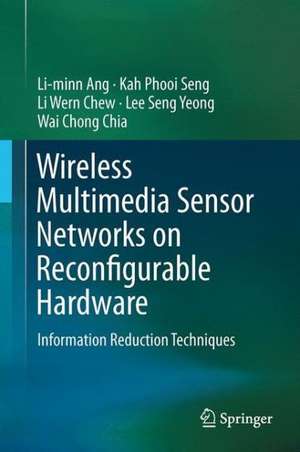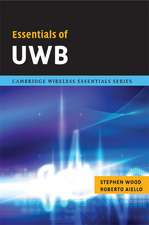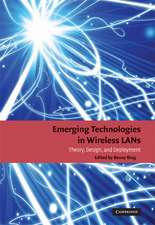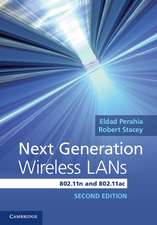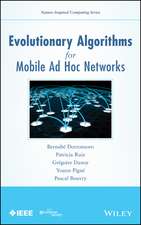Wireless Multimedia Sensor Networks on Reconfigurable Hardware: Information Reduction Techniques
Autor Li-minn Ang, Kah Phooi Seng, Li Wern Chew, Lee Seng Yeong, Wai Chong Chiaen Limba Engleză Hardback – 3 dec 2013
This book describes how reconfigurable hardware technologies such as field-programmable gate arrays (FPGAs) offer cost-effective, flexible platforms for implementing WMSNs, with a main focus on developing efficient algorithms and architectures for information reduction, including event detection, event compression, and multicamera processing for hardware implementations. The authors include a comprehensive review of wireless multimedia sensor networks, a complete specification of a very low-complexity, low-memory FPGA WMSN node processor, and several case studies that illustrate information reduction algorithms for visual event compression, detection, and fusion.
The book will be of interest to academic researchers, R&D engineers, and computer science and engineering graduate students engaged with signal and video processing, computer vision, embedded systems, and sensor networks.
| Toate formatele și edițiile | Preț | Express |
|---|---|---|
| Paperback (1) | 333.04 lei 6-8 săpt. | |
| Springer Berlin, Heidelberg – 23 aug 2016 | 333.04 lei 6-8 săpt. | |
| Hardback (1) | 339.34 lei 6-8 săpt. | |
| Springer Berlin, Heidelberg – 3 dec 2013 | 339.34 lei 6-8 săpt. |
Preț: 339.34 lei
Preț vechi: 424.17 lei
-20% Nou
Puncte Express: 509
Preț estimativ în valută:
64.94€ • 70.52$ • 54.55£
64.94€ • 70.52$ • 54.55£
Carte tipărită la comandă
Livrare economică 22 aprilie-06 mai
Preluare comenzi: 021 569.72.76
Specificații
ISBN-13: 9783642382024
ISBN-10: 3642382029
Pagini: 280
Ilustrații: XXI, 283 p. 73 illus.
Dimensiuni: 155 x 235 x 23 mm
Greutate: 0.61 kg
Ediția:2013
Editura: Springer Berlin, Heidelberg
Colecția Springer
Locul publicării:Berlin, Heidelberg, Germany
ISBN-10: 3642382029
Pagini: 280
Ilustrații: XXI, 283 p. 73 illus.
Dimensiuni: 155 x 235 x 23 mm
Greutate: 0.61 kg
Ediția:2013
Editura: Springer Berlin, Heidelberg
Colecția Springer
Locul publicării:Berlin, Heidelberg, Germany
Public țintă
ResearchCuprins
Chap. 1 Introduction.- Chap. 2 Wireless Multimedia Sensor Network Technology.- Chap. 3 Hardware Technology and Programming Languages for Reconfigurable Devices.- Chap. 4 FPGA Wireless Multimedia Sensor Node Hardware Platforms.- Chap. 5 Single-View Information Reduction Techniques for WMSN Using Event Detection.- Chap. 6 Single-View Information Reduction Techniques for WMSN Using Event Compression.- Chap. 7 Multiple-View Information Reduction Techniques for WMSN Using Image Stitching.- Appendix.- References.
Notă biografică
Dr. Li-Minn Ang received his Ph.D. from Edith Cowan University, Australia in 2001. He was an Associate Professor at the University of Nottingham (Malaysia) and is currently a research fellow at Edith Cowan University. His research interests include visual information processing, hardware architectures, reconfigurable computing, sensor networks, and engineering education. He has published over 100 journal and conference papers in these areas, and has received research grants from the Malaysian government and industry. Dr. Ang is a Fellow of the Higher Education Academy (UK).
Dr. Kah Phooi Seng received her Ph.D. from the University of Tasmania, Australia in 2001. She was an Associate Professor at the University of Nottingham (Malaysia) and is currently a professor in Sunway University, Malaysia. Her research include intelligent visual processing, biometrics and multibiometrics, artificial intelligence, signal processing, and wireless sensor systems. She has published over 100 journal and conference papers in these areas, she has received research grants from the Malaysian government and industry, and she has served as a reviewer for several journals and conferences.
Dr. Li Wern Chew received her Ph.D. from the University of Nottingham in 2007. Her research interests include signal and visual information processing, and hardware architectures. She is currently a member of the Intel Architecture Group in Intel Corporation, Malaysia.
Dr. Lee Seng Yeong received his Ph.D. in 2013 from the University of Nottingham (Malaysia). He is currently a lecturer at Sunway University, Malaysia. His research interests include embedded visual processing and wireless sensor systems.
Dr. Wai Chong Chia received his Ph.D. in 2013 from the University of Nottingham (Malaysia). He is currently a lecturer at Sunway University, Malaysia. His research interests include image and video processing, wireless sensor networks, andembedded systems.
Dr. Kah Phooi Seng received her Ph.D. from the University of Tasmania, Australia in 2001. She was an Associate Professor at the University of Nottingham (Malaysia) and is currently a professor in Sunway University, Malaysia. Her research include intelligent visual processing, biometrics and multibiometrics, artificial intelligence, signal processing, and wireless sensor systems. She has published over 100 journal and conference papers in these areas, she has received research grants from the Malaysian government and industry, and she has served as a reviewer for several journals and conferences.
Dr. Li Wern Chew received her Ph.D. from the University of Nottingham in 2007. Her research interests include signal and visual information processing, and hardware architectures. She is currently a member of the Intel Architecture Group in Intel Corporation, Malaysia.
Dr. Lee Seng Yeong received his Ph.D. in 2013 from the University of Nottingham (Malaysia). He is currently a lecturer at Sunway University, Malaysia. His research interests include embedded visual processing and wireless sensor systems.
Dr. Wai Chong Chia received his Ph.D. in 2013 from the University of Nottingham (Malaysia). He is currently a lecturer at Sunway University, Malaysia. His research interests include image and video processing, wireless sensor networks, andembedded systems.
Textul de pe ultima copertă
Traditional wireless sensor networks (WSNs) capture scalar data such as temperature, vibration, pressure, or humidity. Motivated by the success of WSNs and also with the emergence of new technology in the form of low-cost image sensors, researchers have proposed combining image and audio sensors with WSNs to form wireless multimedia sensor networks (WMSNs). This introduces practical and research challenges, because multimedia sensors, particularly image sensors, generate huge amounts of data to be processed and distributed within the network, while sensor nodes have restricted battery power and hardware resources.
This book describes how reconfigurable hardware technologies such as field-programmable gate arrays (FPGAs) offer cost-effective, flexible platforms for implementing WMSNs, with a main focus on developing efficient algorithms and architectures for information reduction, including event detection, event compression, and multicamera processing for hardware implementations. The authors include a comprehensive review of wireless multimedia sensor networks, a complete specification of a very low-complexity, low-memory FPGA WMSN node processor, and several case studies that illustrate information reduction algorithms for visual event compression, detection, and fusion.
The book will be of interest to academic researchers, R&D engineers, and computer science and engineering graduate students engaged with signal and video processing, computer vision, embedded systems, and sensor networks.
This book describes how reconfigurable hardware technologies such as field-programmable gate arrays (FPGAs) offer cost-effective, flexible platforms for implementing WMSNs, with a main focus on developing efficient algorithms and architectures for information reduction, including event detection, event compression, and multicamera processing for hardware implementations. The authors include a comprehensive review of wireless multimedia sensor networks, a complete specification of a very low-complexity, low-memory FPGA WMSN node processor, and several case studies that illustrate information reduction algorithms for visual event compression, detection, and fusion.
The book will be of interest to academic researchers, R&D engineers, and computer science and engineering graduate students engaged with signal and video processing, computer vision, embedded systems, and sensor networks.
Caracteristici
Focus on efficient algorithms and architectures for information reduction Includes comprehensive review of wireless multimedia sensor network Benefits researchers and engineers in image processing and wireless sensor networks Includes supplementary material: sn.pub/extras
